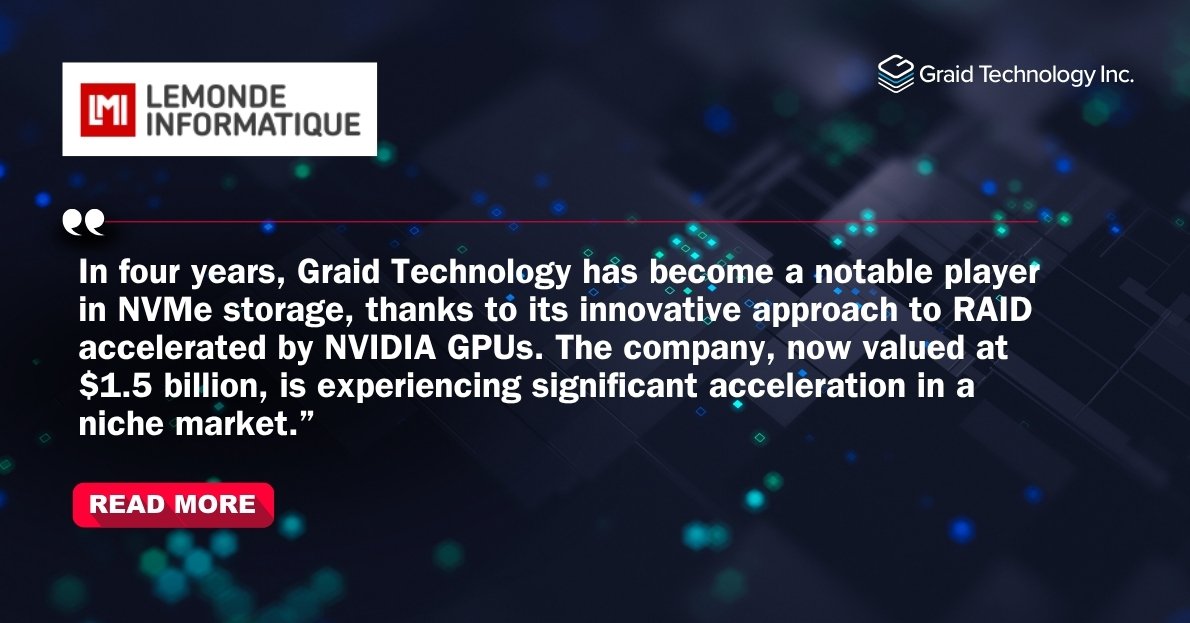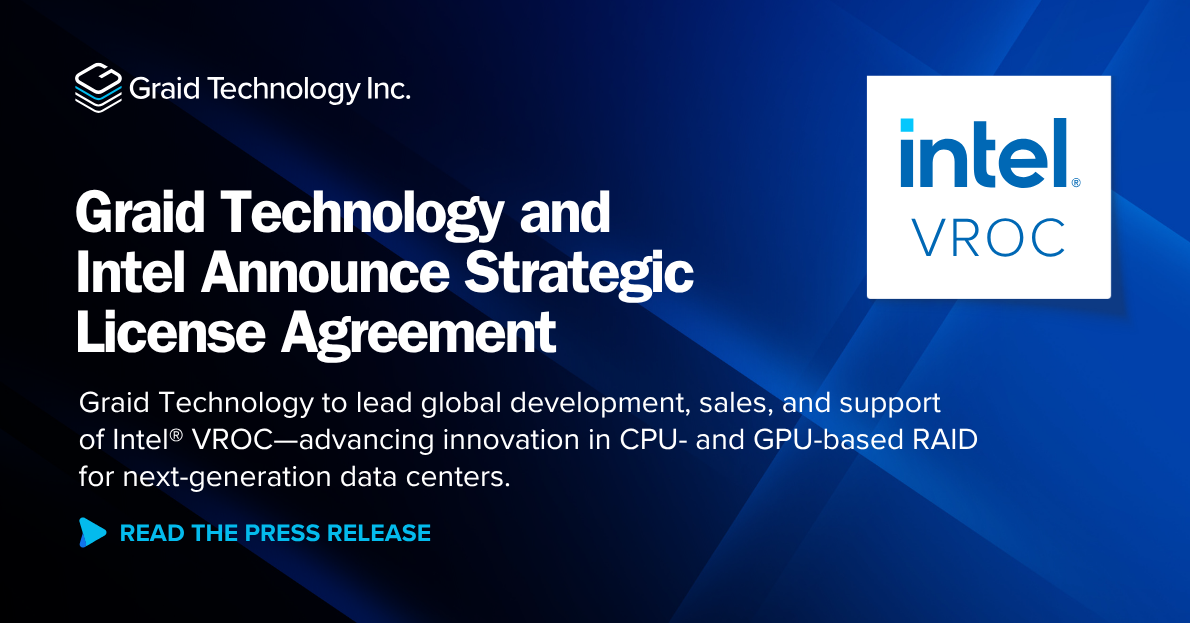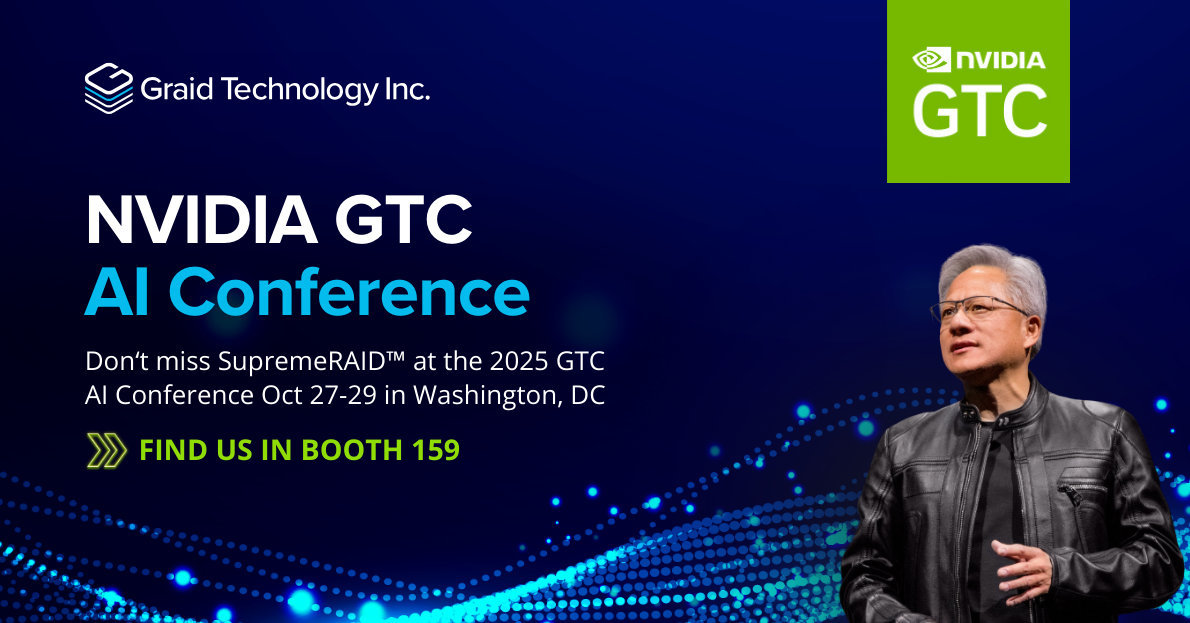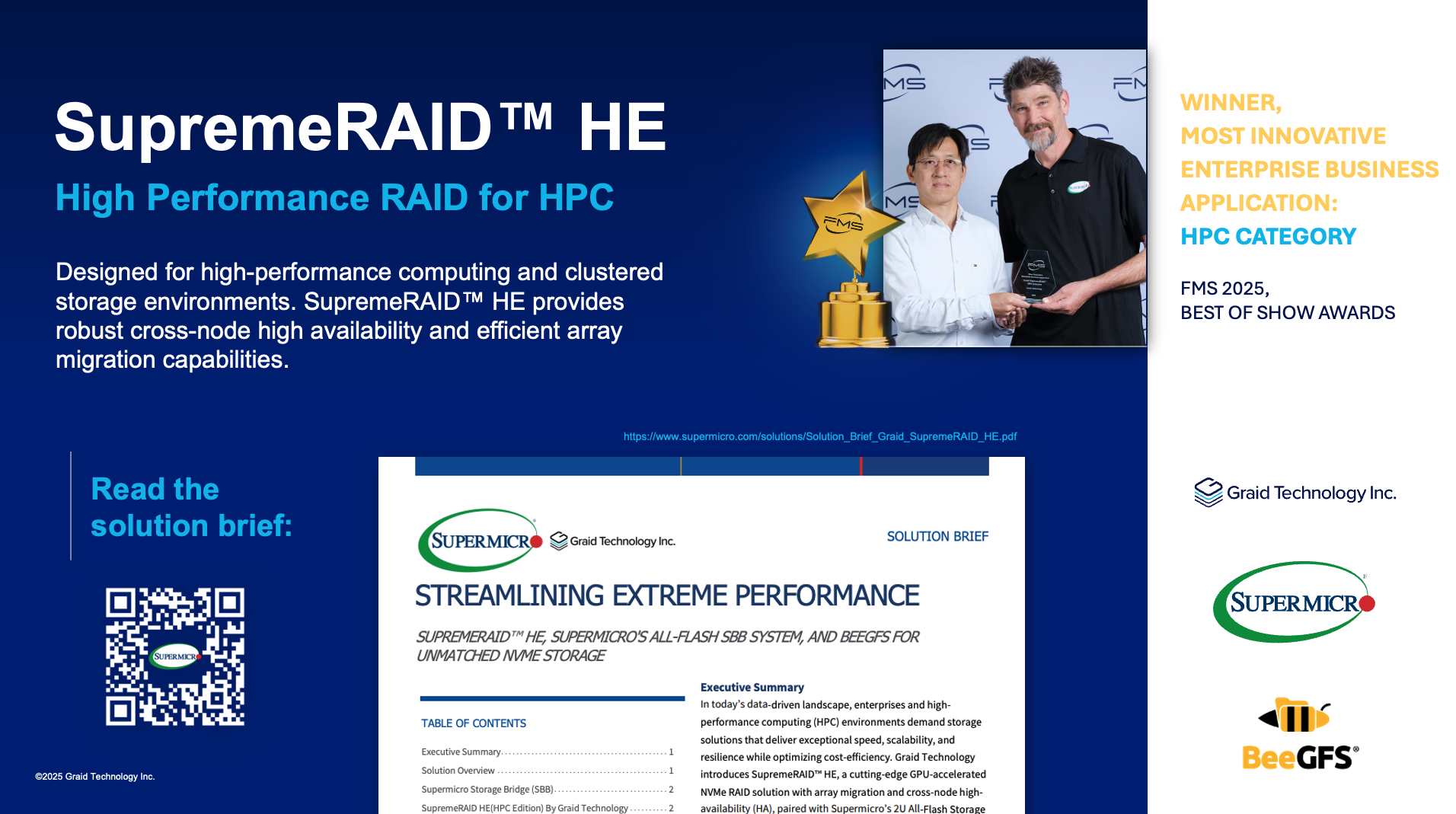
Lemonde Informatique: Graid Technology Addresses HPC and AI Storage Challenges with GPU RAID
Graid Technology’s NVIDIA GPU-accelerated RAID is establishing itself as a benchmark in the storage market. This platform addresses the needs of data centers, AI/HPC clusters, and workstations.
Serge Leblal for Lemonde Informatique, June 5, 2025

In four years, Graid Technology has become a notable player in NVMe storage, thanks to its innovative approach to RAID accelerated by Nvidia GPUs. With nearly 5,000 cards sold in 2024 – a target of 7,000 cards and $15 million in revenue by 2025 – the company, now valued at $1.5 billion, is experiencing significant acceleration in a niche market. During an IT Press Tour session in Palo Alto in early June, Graid presented the expansion of its SupremeRAID catalog with the AE (AI Edition) and HE (HPC Edition) software editions.
Rapid expansion
During his presentation, Tom Paquette, SVP & GM Americas & EMEA at Graid, reminded us of the progress we have made since 2022 : “To say we have come a long way is an understatement. We doubled our revenue between 2023 and 2024, and we expect another 60% growth this year, with more than 7,000 cards or equivalent licenses expected in 2025.” This momentum is supported by a fundraising of more than $55 million, allowing Graid to strengthen its teams (nearly 80 employees to date) and expand its commercial presence. This strategy translates into an ability to deliver worldwide, as Mr. Paquette emphasizes: “Our model, based on standard Nvidia GPUs [whose BIOS is however modified by Graid], allows us to distribute our solutions without major regulatory constraints, which has been an asset from the start.” Graid’s strategy also relies on a vast network of industrial and technological partners, including Nvidia, Supermicro, Dell Technologies, Western Digital, Arm, Intel, Kioxia, as well as specialized distributors such as ASI and Carahsoft for the public sector. According to Tom Paquette, integration into the Nvidia ecosystem has proven decisive: “We are no longer just in the Inception program, but among Nvidia’s 50 strategic start-ups, because we are doing with their products what no one else is doing.”
SupremeRAID: architecture, technical specifications and differentiation
After highlighting the challenges of exponential data growth and the need to fully leverage GPU investments, the marketing manager focused on Graid’s technical value proposition. SupremeRAID is the first NVMe RAID solution to leverage the computing power of Nvidia GPUs, eliminating the bottlenecks of traditional RAID architectures on CPUs or dedicated chipsets. According to Leander Yu, CEO and founder: “We invented the future of storage, making it possible to obtain up to 95% of the raw performance of NVMe SSDs, while freeing up CPU resources for critical applications.” Specifically, SupremeRAID supports RAID levels 0, 1, 5, 6 and 10, up to 32 NVMe SSDs (soon to be 64), on PCIe Gen4/Gen5 platforms, compatible with 1U/2U servers, workstations and HPC clusters2. Throughputs reach 260 GB/s and 28 million IOPS on the most advanced configurations. The architecture leverages direct DMA between GPU memory and SSDs, eliminating latency and CPU path overhead, and automatically benefits from the gains of each new PCIe generation, without software modifications.
Additionally, SupremeRAID offers a modern graphical interface, a RESTful API for integration into IT workflows, and advanced resiliency features: journaling, bad block detection, error handling, and dual parity. The solution is compatible with major flash standards (U.2, M.2, NVMe-oF) and natively integrates with distributed file systems such as BeeGFS, Lustre, and Ceph.
An enriched catalog for AI and HPC
Tom Paquette also highlighted the expansion of the Graid portfolio, with two software solutions: SupremeRAID AE (AI Edition) and SupremeRAID HE (HPC Edition):
– SupremeRAID AE: the answer to the needs of AI servers
SupremeRAID AE targets GPU-intensive servers and AI workloads. It leverages the GPUDirect Storage (GDS) protocol to enable direct transfers between NVMe and GPUs, while integrating an intelligent data offload engine. This approach ensures that GPUs never remain idle in the event of a drive failure, a crucial point for AI infrastructures where the immobilization of a server costing several hundred thousand dollars is unacceptable. Tom Paquette explains: “SupremeRAID AE allows you to achieve more than 95% of raw performance in RAID 5, while avoiding costly GPU inactivity during a drive failure.” Technically, SupremeRAID AE consumes only 6 SMs (Streaming Multiprocessors) on an Nvidia H100 GPU (less than 5% of the capacity), with automatic sleep in case of low activity. The solution integrates natively with BeeGFS, Lustre and Ceph, and can be deployed in shared or dedicated mode as needed.
– SupremeRAID HE: high availability for HPC
SupremeRAID HE, meanwhile, targets HPC environments and scientific clusters. It introduces cross-node high availability (HA) and array migration, enabling increased resilience and optimized resource management in high-performance computing infrastructures. This innovation was co-developed with Supermicro, which sees it as a potential “Weka killer” for HPC storage. With SupremeRAID HE, it becomes possible to maximize usable capacity while maintaining high-level NVMe performance, without resorting to costly redundant replication between nodes. Integration with major HPC file systems (BeeGFS, Ceph, Lustre) is also ensured.
Concrete use cases and global adoption
The vendor’s strength also lies in the diversity of its customers and the variety of use cases it covers. SupremeRAID is currently deployed in sectors ranging from quantitative finance (Novatech, UK) to cybersecurity (Sertrix, Germany), including medical imaging (University of Southampton), defense (US DoD, Aberdeen Proving Grounds), and forensic analysis (TelSwitch). For example, the University of Southampton was able to quadruple the performance of its 3D workflows by replacing its traditional RAID cards with SupremeRAID, while the US DoD selected the solution for its military-grade journaling and high resilience requirements in the field. According to Tom Paquette, this universality is explained by SupremeRAID’s ability to adapt to any demanding workload: “I’m often asked what workload we support best. My answer is always the same: any performance-intensive application, without distinction.”
Roadmap and outlook
Finally, Graid outlined its ambitions for the coming months. The vendor plans to rapidly increase the number of supported drives (beyond 32, towards 64 and more), introduce erasure coding—even if demand is low according to the vendor—to strengthen data protection, and develop the RAID cluster to meet the needs of hyperscalers and exascale infrastructures. Leander Yu summed up the company’s philosophy: “We want to extend our technology to the RAID cluster, to address the needs of hyperscalers and exascale infrastructures. Continuous innovation is our best protection against the competition.”
Nvidia cards used by Graid
Nvidia GPU selection is a central element of Graid Technology’s SupremeRAID architecture, with each solution line optimized for different usage profiles and environments. The company designed its technology to fully leverage the parallel computing power of Nvidia accelerators, leveraging their broad ecosystem and global availability. Here’s a detailed overview of the cards used by product and use case.
SupremeRAID SR-1010 and SR-1000: for enterprise servers
The SupremeRAID SR-1010 and SR-1000 models, deployed primarily in enterprise servers and data centers, have historically relied on Nvidia T1000 GPUs (Turing architecture) and, more recently, on cards from the Ampere family, including the RTX A1000 and A400. These single- and dual-slot PCIe Gen4/Gen3 cards offer a good balance between computing power, energy efficiency and server compatibility, allowing management of up to 32 NVMe SSDs with data rates of up to 260 GB/s and 28 million IOPS depending on the configuration. The move to Ampere GPUs (SR-1000 AM, SR-1001 AM) has allowed Graid to unify its range around single-slot cards, improving compatibility with compact servers while maintaining the high performance expected in mission-critical environments.
SupremeRAID SR-1001: the entry-level solution for SMEs and edge
The SupremeRAID SR-1001 card targets edge servers, SMBs, and advanced workstations. It leverages Nvidia T400 or RTX A400 GPUs, featuring low-profile, low-power designs, while delivering up to 80 GB/s of bandwidth and 6 million IOPS across 8 NVMe SSDs. This solution addresses performance and resiliency needs in environments where cost and compactness are critical.
SupremeRAID SE: the flexibility of Bring Your Own GPU
With SupremeRAID SE, Graid offers a “Bring Your Own GPU” software solution for workstation and creative users. This edition supports the entire Nvidia GeForce RTX 5000 (Blackwell) series, including the consumer RTX 5090, 5080, 5070 Ti, 5070, and 5060. Users can configure software RAID across 4 to 8 NVMe SSDs, leveraging the capabilities of the latest generation of consumer GPUs for demanding applications (creation, AI, 3D rendering), while benefiting from GDDR7 memory and the advancements of the Blackwell architecture.
SupremeRAID AE (AI Edition): Optimization for AI servers
The AE version, a software license actually dedicated to AI servers and intensive workloads, is designed to run on Nvidia H100, H200 and B100 GPUs (Hopper and Blackwell architecture), i.e. the most powerful cards on the market, capable of handling massive computing and storage loads in parallel2. SupremeRAID AE leverages GPUDirect Storage for direct transfers between NVMe SSD and GPU memory, while consuming a minimal fraction of the GPU capacity (6 SMs out of 144 for an H100), thus ensuring that almost all resources remain available for AI.
SupremeRAID HE (HPC Edition): high availability for HPC
Finally, SupremeRAID HE, optimized for HPC clusters, relies on the same high-end Nvidia GPU families (H100, H200, B100), to ensure high inter-node availability and array migration in very data-intensive scientific or industrial environments.
Article written by Serge Leblal, Editorial Director of IT News Info



